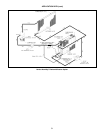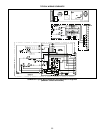49
APPLICATION DATA
1.
CONDENSATE DRAIN PAN —
A sloped condensate drain
pan is supplied on all units. The condensate pan must be
externally trapped. Condensate drains are located on both
the bottom and end of the unit.
2.
DUCTWORK —
All ductwork must be attached to flanges.
If no flanges are present, they must be field supplied.
Secure vertical discharge ductwork to roof curb. For hori-
zontal discharge applications, attach ductwork to flanges.
Field-supplied flanges can be attached to horizontal dis-
charge openings and all ductwork attached to flanges.
3. TO CONVERT FROM VERTICAL DISCHARGE TO HORI-
ZONTAL DISCHARGE (Durablade Economizer Only):
a. Remove economizer/two-position damper to gain access
to return duct opening.
b. Move the horizontal-discharge duct opening covers to
the vertical discharge openings.
c. Rotate economizer 90 degrees (until the economizer/
two-position damper motor faces the condenser section).
d. Rotate the barometric relief damper 90 degrees.
e. Install block-off plate over the opening on the access
panel.
4.
THERMOSTAT —
Use of 2-stage cooling thermostat is
recommended for all size 036-072 units equipped with
economizer.
5.
HEATING-TO-COOLING CHANGEOVER —
All units are
automatic changeover from heating to cooling when auto-
matic changeover thermostat and subbase are used.
6.
AIRFLOW —
Units are draw-thru on cooling and blow-thru
on heating.
7.
MAXIMUM AIRFLOW —
To minimize possibility of conden-
sate blow-off from evaporator, airflow through units should
not exceed 500 cfm/ton.
8.
MINIMUM AIRFLOW —
Minimum airflow for cooling is
300 cfm/ton.
9.
MINIMUM AMBIENT OPERATING TEMPERATURE —
Minimum ambient operating temperature for size 036-150
standard units is 25 F. With accessory Motormaster
®
or
Motormaster II control, units can operate at outdoor tem-
peratures down to –20 F.
10.
MAXIMUM OPERATING OUTDOOR-AIR TEMPERATURE
—
Maximum outdoor-air operating temperature for cooling
is 125 F.
11.
HIGH ALTITUDES —
These may require a change to the
gas orifice. Refer to Altitude Compensation tables on
page 43.
12.
MINIMUM TEMPERATURE —
Minimum temperature of air
entering the dimpled heat exchanger is 50 F continuous
and 45 F intermittent.
13.
MOTOR DATA —
Due to Bryant’s internal unit design
(draw-thru over the motor), air path, and specially designed
motors, the full horsepower (maximum continuous bhp)
listed in the Physical Data table and the notes following
each Fan Performance table can be utilized with extreme
confidence.
Using Bryant motors to the values listed in the Physical
Data, Fan Performance, and Evaporator-Fan Motor Data
tables
will not
result in nuisance tripping or premature
motor failure. In addition, the unit warranty will not be
affected.
14.
THRU-THE-BOTTOM CONNECTIONS —
The accessory
thru-the-bottom connections are needed to ensure proper
connections when routing wiring and piping through the
basepan and roof curb. This accessory is used for electric
and control power only.
15.
PERFECT HUMIDITY™ DEHUMIDIFICATION PACKAGE
—
This option provides greater dehumidification by further
subcooling the hot liquid refrigerant leaving the condenser
coil. The Perfect Humidity package consists of a subcooling
coil located on the leaving-air side of the evaporator coil.
The location of the coil in the indoor airstream enhances
the latent capacity of the 581B rooftop units by up to 40%.
Many buildings suffer damage or have poor indoor-air qual-
ity due to overly humid conditions. Building humidity must
be controlled for the following reasons:
a.
INDOOR-AIR QUALITY —
Humidity is a major factor in
the growth and propagation of mold and mildew in a
building. The mold and mildew can spread quickly and
grow in carpets and ductwork and on walls, and often
causes cases of sick building syndrome. This syndrome
can lead to employee absenteeism due to illness, lower
worker productivity, and increased health care costs.
The American Society of Heating, Refrigeration, and
Air Conditioning Engineers (ASHRAE) recommends
that relative humidity levels in buildings be maintained
below 70%.
b.
COMFORT LEVELS —
High humidity levels cause the
occupied space to become uncomfortable, because
humidity interferes with the body’s natural cooling pro-
cess (evaporation at the skin surface).
c.
HUMIDITY DAMAGE —
Humidity causes property
damage, such as stained wallpaper and ceiling tiles.
Humidity can also damage books and artwork, and
create strong odors in carpets. In addition, humidity can
contribute to unacceptable product quality in industrial
processes.
d.
IMPROPER VENTILATION —
Buildings in hot and
humid geographical areas cannot be properly ventilated
due to high humidity levels outdoors, resulting in poor
indoor-air quality.
e.
EQUIPMENT INEFFICIENCY —
Humidity can cause
inefficient operation of refrigerators and freezers.
f.
INCREASED ENERGY COSTS —
Because of high
humidity levels and less comfortable conditions, ther-
mostat set points are lowered to force the HVAC (heat-
ing, ventilation, and air conditioning) equipment to run
longer and work harder to lower the humidity levels.
Also, in an attempt to control humidity, system design-
ers typically oversize HVAC equipment and add reheat
capability to get the desired latent capacity. This results
in higher initial equipment costs, as well as increased
energy expenses throughout the life of the unit.
Applications
There are many different rooftop unit applications that are
susceptible to problems caused by high humidity levels.
Some common applications include:
a.
RESTAURANTS —
The kitchen areas of restaurants
have many humidity-producing activities, such as dish
washing and cooking.
b.
SUPERMARKETS —
High humidity levels cause ineffi-
ciency in operation of refrigeration and freezer systems.
c.
MUSEUMS AND LIBRARIES —
Humidity can damage
books and artwork.
d.
GYMNASIUMS, LOCKER ROOMS, AND HEALTH
CLUBS —
Shower areas and human perspiration
cause uncomfortable occupied space conditions.
e.
HOT AND HUMID CLIMATES —
The southeastern
United States is a good example of this application. The
Perfect Humidity dehumidification package becomes
particularly useful when increased amounts of the hot
and humid outdoor air need to be brought into the build-
ing for proper ventilation.
16.
PERFECT HUMIDITY DEHUMIDIFICATION PACKAGE
DESIGN EFFECTS —
To fully understand the operation of
the Perfect Humidity dehumidification package, refer to the
pressure enthalpy curve, and analyze the Perfect Humidity
package effects on the refrigerant in the rooftop unit. The
pressure enthalpy curve shows the refrigerant cycle for a
581B rooftop unit.


















